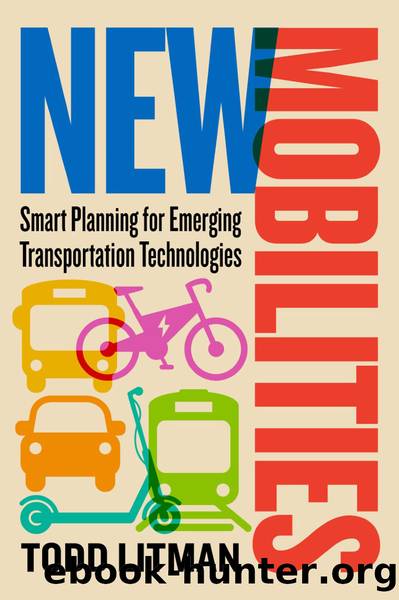Transforming Cities With Transit: Transit and Land-Use Integration for Sustainable Urban Development by Hiroaki Suzuki & Robert Cervero & Kanako Iuchi

Author:Hiroaki Suzuki & Robert Cervero & Kanako Iuchi [Suzuki, Hiroaki & Cervero, Robert & Iuchi, Kanako]
Language: eng
Format: epub
Tags: Business & Economics, Urban & Regional, Development, Economic Development, Sustainable Development
ISBN: 9780821397459
Google: ruWxV2NsCTsC
Publisher: World Bank Publications
Published: 2013-01-10T00:10:15.700522+00:00
Chapter 7
Recommendations for Optimizing New Mobilities
This chapter describes specific ways that communities can implement New Mobility to maximize their benefits and minimize potential problems.
What Others Recommend
Many experts and organizations offer advice for implementing New Mobilities. These vary in perspective and scope. Advocates highlight the benefits of emerging modes, and so recommend their speedy implementation.1 Skeptics highlight their costs and risks and recommend policies to limit negative impacts.2 Some try to provide balanced recommendations.3
For example, Bruce Schallerâs report The New Automobility evaluates ridehailing impacts.4 It concludes that ridehailing can provide significant benefits but warns, âWithout public policy intervention, big American cities are likely to be overwhelmed with more automobility, more traffic and less transit and drained of the density and diversity which are indispensable to their economic and social well-being.â It recommends policies to prevent ridehailing from increasing traffic problems and inequity.
The National Association of City Transportation Officialsâ Guidelines for Regulating Shared Micromobility recognizes the potential benefits of scooter, bike, and e-bike sharing services, but also various costs and risks they can impose, and so recommends policies to ensure they are used safely and responsibly.5 These include municipal standards for compliance, equipment, service quality, data integrity, and fleet size, plus regulations and programs to minimize conflicts in public rights-of-way.
Daniel Sperlingâs book Three Revolutions highlights the potential benefits of automated, electric, and shared vehicles but recognizes potential problems if they increase total vehicle travel and sprawl, as well as the need for policies that favor more resource-efficient modes.6 The National Association of City Transportation Officialsâ Blueprint for Autonomous Urbanism recommends that, to maximize community benefits, autonomous vehicle policies should emphasize safety, maximize person rather than vehicle throughput, and ensure that benefits are distributed equitably.7 It warns that âautomation without a comprehensive overhaul of how our streets are designed, allocated, and shared will not result in substantive safety, sustainability, or equity gains.â
Hana Creger, Joel Espino, and Alvaro S. Sanchezâs report Autonomous Vehicle Heaven or Hell? Creating a Transportation Revolution that Benefits All for the Greenline Institute, an environmental and social equity advocacy organization, concludes that âif left up to the free market without adequate regulation, we can expect a âhellâ scenario dominated by personally-owned autonomous vehicles that are only accessible to those who can afford them, while further congesting our streets and polluting our air, leaving others to cope with worse traffic, longer commutes and under-resourced public transit.â8 To achieve more positive results they recommend policies that favor fleets of autonomous vehicles that are electric and shared (FAVES). Similarly, Tom Cohen and Clémence Cavoliâs article âAutomated Vehicles: Exploring Possible Consequences of Government (non)intervention for Congestion and Accessibilityâ argues that laissez-faire free-market policies will cause autonomous vehicles to increase traffic congestion and reduce accessibility for non-drivers, resulting in undesirable outcomes.9
Stephen Goldsmithâs Governing magazine article âAn Impact Framework for the New Mobilityâ recommends that New Mobility planning should consider these impacts:10
â¢Access and equity: How do decisions increase or decrease access and for whom, and how do they mitigate or aggravate equity issues?
â¢Environment: How do transportation
Download
This site does not store any files on its server. We only index and link to content provided by other sites. Please contact the content providers to delete copyright contents if any and email us, we'll remove relevant links or contents immediately.
Zero to IPO: Over $1 Trillion of Actionable Advice from the World's Most Successful Entrepreneurs by Frederic Kerrest(4073)
Machine Learning at Scale with H2O by Gregory Keys | David Whiting(3653)
Harry Potter and the Goblet Of Fire by J.K. Rowling(3615)
Never by Ken Follett(3545)
Ogilvy on Advertising by David Ogilvy(3349)
Shadow of Night by Deborah Harkness(3181)
The Man Who Died Twice by Richard Osman(2818)
Book of Life by Deborah Harkness(2725)
My Brilliant Friend by Elena Ferrante(2707)
How Proust Can Change Your Life by Alain De Botton(2619)
0041152001443424520 .pdf by Unknown(2605)
Will by Will Smith(2589)
The Tipping Point by Malcolm Gladwell(2565)
How to Pay Zero Taxes, 2018 by Jeff A. Schnepper(2505)
Purple Hibiscus by Chimamanda Ngozi Adichie(2501)
Hooked: A Dark, Contemporary Romance (Never After Series) by Emily McIntire(2428)
Rationality by Steven Pinker(2156)
Borders by unknow(2121)
Daughter of Smoke and Bone by Laini Taylor(2086)
